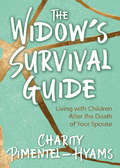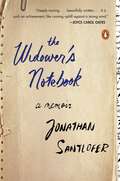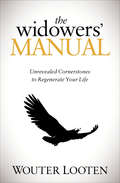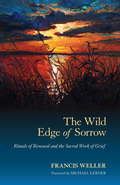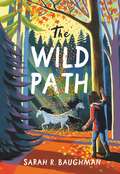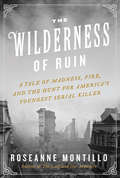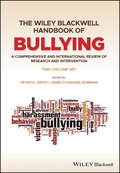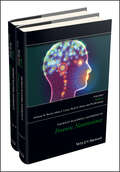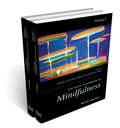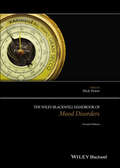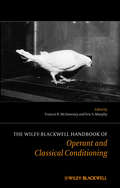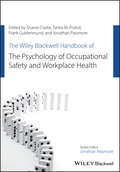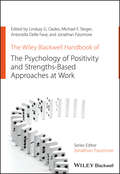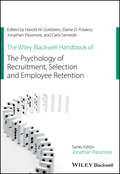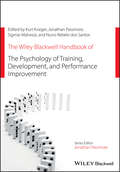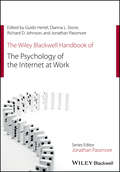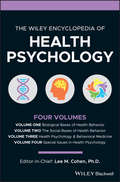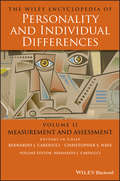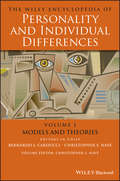- Table View
- List View
The Widow's Survival Guide: Living with Children After the Death of Your Spouse
by Charity Pimentel-Hyams“Charity offers hope and practical steps through the darkness and difficulty of grief into the light and new possibilities of life.” —The Reverend Tracy Fye WeatherhoggWithin The Widow’s Survival Guide, Charity Pimentel-Hyams, a widow at thirty-seven with children aged five, three, and one at the time of her husband’s tragic and unexpected death, takes women through the challenges and triumphs of young widowhood. Throughout The Widow’s Survival Guide, women learn:What to do directly after the death of their spouseHow to support themselves and handle grieving children, even when they’re falling apartWhat grief can look like and the symptoms it createsHow to create an action plan for day-to-day lifeStrategies to check in with their heart and stay connected to their lost loved one“A brave and deeply human account of embracing unbearable loss . . . powerful medicine for anyone suffering loss.” —Robin Winn, LMFT“A heartbreaking journey of myriad emotions, love, and loss. I found myself holding my breath through some of the painfully practical details and advice to widows. The love expressed in this book in tangible, honest and devastating.” —Ana-Maria Figueredo, author of The Secret Art of Selling Insurance“Just the right mix of practicality and existentialism . . . anticipates and normalizes the complex emotions associated with early widowhood.” —Megan Greenleaf, MD
The Widower's Notebook: A Memoir
by Jonathan SantloferWritten with unexpected humor and great warmth, The Widower's Notebook is a portrait of a marriage, an account of the complexities of finding oneself single again after losing your spouse, and a story of the enduring power of familial love."This is deeply moving ... beautifully written and modulated, with a dollop of droll, black humor. It is such an achievement, like running uphill against a strong wind."--Joyce Carol OatesOn a summer day in New York Jonathan Santlofer discovers his wife, Joy, gasping for breath on their living room couch. After a frenzied 911 call, an ambulance race across Manhattan, and hours pacing in a hospital waiting room, a doctor finally delivers the fateful news. Consumed by grief, Jonathan desperately tries to pursue life as he always had--writing, social engagements, and working on his art--but finds it nearly impossible to admit his deep feelings of loss to anyone, not even his to beloved daughter, Doria, or to himself. As Jonathan grieves and heals, he tries to unravel what happened to Joy, a journey that will take him nearly two years.
The Widowers' Manual: Unrevealed Cornerstones to Regenerate Your Life
by Wouter LootenThe author of I&’m Sorry for Your Loss presents a practical guidebook for men who have lost their wives and are struggling to move forward in their grief. In The Widowers&’ Manual, Wouter Looten—who lost his wife more than a decade ago—uses his own journey and experience to effectively guide you through a new and strange world: the realm of the widower. When you find yourself in this unknown reality you feel lost, angry, and numb. Now get ready to exchange these negative sensations for empowerment, caring, and being present in the world. The Widowers&’ Manual presents a set of five anchors that helps you, step by step, to sort out the biggest challenge you have had to deal with: the death of your partner. This comprehensive book offers you a practical outline on how to get back on track. It reveals how to put the experience of becoming a widower into perspective in a way that gives you the ability to create order from chaos. This is not your everyday book on how you could overcome your spouse&’s demise. The Widowers&’ Manual shows you how to proficiently turn the experience of losing your loved one into new ways in which you can create a prosperous and compelling future.
The Widows' Handbook
by Jacqueline Lapidus Lise MennWidows convey their feelings and survival strategies in this compelling anthologyThe Widows' Handbook is the first anthology of poems by contemporary widows, many of whom have written their way out of solitude and despair, distilling their strongest feelings into poetry or memoir. This stirring collection celebrates the strategies widows learn and the resources they muster to deal with people, living space, possessions, social life, and especially themselves, once shock has turned to the realization that nothing will ever be the same. As Supreme Court Justice Ruth Bader Ginsburg says in her foreword, losing one's partner is "a loss like no other. "The Widows' Handbook is a collection of poetry from 87 American women of all ages, legally married or not, straight and gay, whose partners or spouses have died. Some of the poets are already published widely--including more than a dozen prizewinners, four Pushcart nominees, and two regional poets laureate. Others are not as well known, and some appear in print for the first time here. With courage and wry humor, these women encounter insidious depression, poignant memories, bureaucratic nonsense, unfamiliar hardware, well-intentioned but thoughtless remarks, demanding work, spiritual revelation, and unexpected lust, navigating new relationships in the uncertain legacy of sexual liberation. They write frankly about being paralyzed and about going forward. Their poems are honest, beautiful, and accessible. Only poetry can speak such difficult truths and incite such intense empathy. While both men and women understand the bewilderment, solitude, and change of status thrust upon the widowed, women suffer a particular social demotion and isolation. Anyone who has lost a loved one or is involved in helping the bereaved will be able to relate to the experiences conveyed in The Widows' Handbook.
The Wild Edge of Sorrow: Rituals of Renewal and the Sacred Work of Grief
by Michael Lerner Francis WellerNoted psychotherapist Francis Weller provides an essential guide for navigating the deep waters of sorrow and loss in this lyrical yet practical handbook for mastering the art of grieving. Describing how Western patterns of amnesia and anesthesia affect our capacity to cope with personal and collective sorrows, Weller reveals the new vitality we may encounter when we welcome, rather than fear, the pain of loss. Through moving personal stories, poetry, and insightful reflections he leads us into the central energy of sorrow, and to the profound healing and heightened communion with each other and our planet that reside alongside it.The Wild Edge of Sorrow explains that grief has always been communal and illustrates how we need the healing touch of others, an atmosphere of compassion, and the comfort of ritual in order to fully metabolize our grief. Weller describes how we often hide our pain from the world, wrapping it in a secret mantle of shame. This causes sorrow to linger unexpressed in our bodies, weighing us down and pulling us into the territory of depression and death. We have come to fear grief and feel too alone to face an encounter with the powerful energies of sorrow. Those who work with people in grief, who have experienced the loss of a loved one, who mourn the ongoing destruction of our planet, or who suffer the accumulated traumas of a lifetime will appreciate the discussion of obstacles to successful grief work such as privatized pain, lack of communal rituals, a pervasive feeling of fear, and a culturally restrictive range of emotion. Weller highlights the intimate bond between grief and gratitude, sorrow and intimacy. In addition to showing us that the greatest gifts are often hidden in the things we avoid, he offers powerful tools and rituals and a list of resources to help us transform grief into a force that allows us to live and love more fully.From the Trade Paperback edition.
The Wild Other: A memoir of love, adventure and how to be brave
by Clover StroudSHORTLISTED FOR THE WAINWRIGHT PRIZE'Extraordinary, and a painful but invigorating read. I've never met anyone who has read it and doesn't rank it as one of their favourite books.' Dolly Alderton'This story - so fierce and brave and visceral and raw - will stay with me forever. Clover Stroud is a force of nature, and a woman who is fearless in the face of life and death. I loved it.' Elizabeth Gilbert, author of Eat Pray Love'There is so much richly evoked life here... beautifully written.' Cathy Rentzenbrink, The Times'This redemptive memoir will steal your heart; it will return it bruised but emboldened.' Mail on Sunday'I have huge admiration for the spirit of this memoir, and its author: full of heart, bravery and adventure. A moving, gripping read.' Amy Liptrot, author of The OutrunClover Stroud grew up in rural Wiltshire surrounded by animals and family. When she was just sixteen her adored mother had a horrific riding accident which left her permanently brain-damaged, and suddenly Clover was left to fend for herself. She embarked on an extraordinary journey to heal her broken heart, courting men and danger through two marriages and five children.The Wild Other is a grippingly honest account of love, sex and travelling to the darkest edges of human experience and back again. Powerful and deeply emotional, this is the story of an extraordinary life lived at its fullest.
The Wild Other: A memoir of love, adventure and how to be brave
by Clover StroudSHORTLISTED FOR THE WAINWRIGHT PRIZE'Extraordinary, and a painful but invigorating read. I've never met anyone who has read it and doesn't rank it as one of their favourite books.' Dolly Alderton'This story - so fierce and brave and visceral and raw - will stay with me forever. Clover Stroud is a force of nature, and a woman who is fearless in the face of life and death. I loved it.' Elizabeth Gilbert, author of Eat Pray Love'There is so much richly evoked life here... beautifully written.' Cathy Rentzenbrink, The Times'This redemptive memoir will steal your heart; it will return it bruised but emboldened.' Mail on Sunday'I have huge admiration for the spirit of this memoir, and its author: full of heart, bravery and adventure. A moving, gripping read.' Amy Liptrot, author of The OutrunClover Stroud grew up in rural Wiltshire surrounded by animals and family. When she was just sixteen her adored mother had a horrific riding accident which left her permanently brain-damaged, and suddenly Clover was left to fend for herself. She embarked on an extraordinary journey to heal her broken heart, courting men and danger through two marriages and five children.The Wild Other is a grippingly honest account of love, sex and travelling to the darkest edges of human experience and back again. Powerful and deeply emotional, this is the story of an extraordinary life lived at its fullest.
The Wild Other: A memoir of love, adventure and how to be brave
by Clover StroudClover Stroud's idyllic childhood in rural England was shattered when a horrific riding accident left her mother permanently brain-damaged. Just sixteen, she embarked on a journey to find the sense of home that had been so savagely broken. Travelling from gypsy camps in Ireland, to the rodeos of west Texas and then to Russia's war-torn Caucasus, Clover eventually found her way back to England's lyrical Vale of the White Horse.The Wild Other is a grippingly honest account of love, loss, family and the healing strength of nature. Powerful and deeply emotional, this is the story of an extraordinary life lived at its fullest.(P) 2017 Hodder & Stoughton
The Wild Path
by Sarah R. BaughmanThe Line Tender meets The Secret Horses of Briar Hill in this hopeful, heartfelt story about one girl's search for legendary horses and her quest to piece her family back together.Twelve-year-old Claire Barton doesn't like the "flutter feeling" that fills her chest when she worries about the future, but she knows what she loves: the land that's been in her family for three generations; her best friend Maya; her family's horses, Sunny and Sam; and her older brother Andy. That's why, with Andy recently sent to rehab and her parents planning to sell the horses, Claire's world feels like it might flutter to pieces.When Claire learns about equine therapy, she imagines a less lonely future that keeps her family together, brother and horses included. But, when she finds what seem to be mysterious wild horses in the woods behind her house, she realizes she has a bit more company than she bargained for. With this new secret -- and a little bit of luck -- Claire will discover the beauty of change, the power of family, and the strength within herself.
The Wilderness of Ruin
by Roseanne MontilloAn enthralling tale of madness and murder, set against the backdrop of Boston's Great Fire and America's Gilded AgeIn 1871, young children were disappearing from Boston's working- class neighborhoods. The few who returned told desperate tales of being taken to the woods and tortured by a boy not much older than themselves. The police were skeptical--these children were from poor families, so their testimony was easily discounted. And after the Great Boston Fire of 1872 reduced much of downtown to rubble, the city had more pressing concerns. Finally, when the police apprehended Jesse Pomeroy for the crimes, he, like any twelve-year-old, was sent off to reform school. Little thought was given to the danger he might pose to society, despite victims' chilling reports of this affectless Boy Torturer.Sixteen months later, Jesse was released in the care of his mother, and within months a ten-year-old girl and a four-year-old boy went missing, their mutilated bodies later discovered by police. This set off a frantic hunt for Pomeroy, who was now proclaimed America's youngest serial killer. When he was captured and brought to trial, his case transfixed the nation, and two public figures--Herman Melville and Oliver Wendell Holmes--each probed the depths of Pomeroy's character in a search for the meaning behind his madness.Roseanne Montillo, author of the acclaimed The Lady and Her Monsters, takes us inside those harrowing years, as a city reeling from great disaster reckoned with the moral quandaries posed by Pomeroy's spree. What makes a person good or evil? How do we develop as moral beings? At what age do we hold someone responsible for violating society's moral code? And what does our fascination with such ghastly deeds reveal about us?The Wilderness of Ruin is a dazzling combination of true-crime thrills, a fresh perspective on mental illness, and a fascinating look at American class turmoil that captures the spirit of a turbulent age.
The Wiley Blackwell Handbook of Bullying: A Comprehensive and International Review of Research and Intervention
by Peter K. Smith James O’Higgins NormanExplore the latest research and theory on bullying with this international reference from leading voices in the field The two-volume Wiley-Blackwell Handbook of Bullying delivers a comprehensive exploration of a wide range of research on bullying, broadly defined. School bullying is dealt with at length, but there is also coverage of college and workplace bullying and bullying within sports settings, prisons, families, and elder care residential homes. Containing contributions from leading scholars on five continents, the book summarizes the latest theories, findings, developmental aspects, and interventions relevant to bullying in a variety of settings. With up-to-date information on rapidly developing topics like sibling bullying, cyberbullying, bias-based bullying, migration and bullying, dating violence, and economic evaluation of bullying prevention programs, The Wiley-Blackwell Handbook of Bullying offers readers a complete view of a wide array of bullying behaviors. The insightful and up-to-date information contained within the two volumes is destined to become the standard reference for bullying-related research and theory. Readers will benefit from: Fulsome material covering research and practice conventions in countries and regions including Europe, North America, South America, Australasia, Japan, South Korea, India, Mainland China and Hong Kong, the Arab countries, and sub-Saharan Africa A comprehensive discussion on the correlates and outcomes of taking part in bullying, as well as being a victim of bullying An exploration of a variety of strategies to deal with bullying incidents, including proactive, reactive, and peer support approaches An analysis of different kinds of bullying, faith-based bullying, and disablist bullying, including racist and ethnic bullying, sexist and sexual bullying, and homophobic and transphobic bullying Perfect for postgraduate students in programs dealing with bullying in virtually any conceivable context, The Wiley-Blackwell Handbook of Bullying will also earn a place in the libraries of researchers and practitioners in fields as diverse as psychology, sociology, social work, medicine, criminology, child care, and elder studies.
The Wiley Blackwell Handbook of Forensic Neuroscience
by Anthony R. Beech Adam J. Carter Ruth E. Mann Pia RotshteinExplores how the explosion of neuroscience-based evidence in recent years has led to a fundamental change in how forensic psychology can inform working with criminal populations. This book communicates knowledge and research findings in the neurobiological field to those who work with offenders and those who design policy for offender rehabilitation and criminal justice systems, so that practice and policy can be neurobiologically informed, and research can be enhanced. Starting with an introduction to the subject of neuroscience and forensic settings, The Wiley Blackwell Handbook of Forensic Neuroscience then offers in-depth and enlightening coverage of the neurobiology of sex and sexual attraction, aggressive behavior, and emotion regulation; the neurobiological bases to risk factors for offending such as genetics, developmental, alcohol and drugs, and mental disorders; and the neurobiology of offending, including psychopathy, antisocial personality disorders, and violent and sexual offending. The book also covers rehabilitation techniques such as brain scanning, brain-based therapy for adolescents, and compassion-focused therapy. The book itself: Covers a wide array of neuroscience research Chapters by renowned neuroscientists and criminal justice experts Topics covered include the neurobiology of aggressive behavior, the neuroscience of deception, genetic contributions to psychopathy, and neuroimaging-guided treatment Offers conclusions for practitioners and future directions for the field. The Handbook of Forensic Neuroscience is a welcome book for all researchers, practitioners, and postgraduate students involved with forensic psychology, neuroscience, law, and criminology.
The Wiley Blackwell Handbook of Judgment and Decision Making
by George Wu Gideon KerenA comprehensive, up-to-date examination of the most important theory, concepts, methodological approaches, and applications in the burgeoning field of judgment and decision making (JDM) Emphasizes the growth of JDM applications with chapters devoted to medical decision making, decision making and the law, consumer behavior, and more Addresses controversial topics from multiple perspectives – such as choice from description versus choice from experience – and contrasts between empirical methodologies employed in behavioral economics and psychology Brings together a multi-disciplinary group of contributors from across the social sciences, including psychology, economics, marketing, finance, public policy, sociology, and philosophy 2 Volumes
The Wiley Blackwell Handbook of Mindfulness (Wiley Clinical Psychology Handbooks Ser.)
by Amanda IeThe Wiley Blackwell Handbook of Mindfulness brings together the latest multi-disciplinary research on mindfulness from a group of international scholars: Examines the origins and key theories of the two dominant Western approaches to mindfulness Compares, contrasts, and integrates insights from the social psychological and Eastern-derived perspectives Discusses the implications for mindfulness across a range of fields, including consciousness and cognition, education, creativity, leadership and organizational behavior, law, medical practice and therapy, well-being, and sports 2 Volumes
The Wiley Blackwell Handbook of Mood Disorders
by Mick PowerThe Wiley-Blackwell Handbook of Mood Disorders, 2/e reflects the important and fast-changing advancements that have occurred in theory and practice in unipolar and bipolar mood disorders. There is no other current reference that gathers all of these developments together in a single bookEvery chapter is updated to reflect the very latest developments in theory and practice in unipolar and bipolar mood disordersIncludes additional chapters which cover marital and family therapy, medical disorders and depression, and cross-cultural issuesContributions are from the world's leading authorities, and include psychiatrists and clinical psychologists with experience in both research and in practiceFocuses on innovations in science and clinical practice, and considers new pharmacological treatments as well as psychological therapies
The Wiley Blackwell Handbook of Operant and Classical Conditioning
by Frances K. McSweeney Eric S. MurphyThis combined survey of operant and classical conditioning provides professional and academic readers with an up-to-date, inclusive account of a core field of psychology research, with in-depth coverage of the basic theory, its applications, and current topics including behavioral economics. Provides comprehensive coverage of operant and classical conditioning, relevant fundamental theory, and applications including the latest techniques Features chapters by leading researchers, professionals, and academicians Reviews a range of core literature on conditioning Covers cutting-edge topics such as behavioral economics
The Wiley Blackwell Handbook of Social Anxiety Disorder
by Justin W. WeeksFeaturing leading international authors working in clinical psychology and psychiatry, this handbook offer the most in-depth coverage of social anxiety disorder, including personality factors in SAD, and multicultural issues in the diagnosis, case conceptualization, and treatment of SAD.A multi-contributed, internationally diverse handbook covering all major elements of social anxiety disorder, offering an invaluable teaching toolThis unique text contributes significantly to the field by summarizing the current state of research in the area and outlining future directionsProvides a comprehensive overview of applied, empirically-supported techniques in the conceptualization, assessment, and treatment of SAD
The Wiley Blackwell Handbook of the Psychology of Occupational Safety and Workplace Health
by Jonathan Passmore Frank W. Guldenmund Sharon Clarke Tahira M. ProbstA Wiley Blackwell Handbook of Organizational Psychology focusing on occupational safety and workplace health. The editors draw on their collective experience to present thematically structured material from leading thinkers and practitioners in the USA, Europe, and Asia Pacific Provides comprehensive coverage of the major contributions that psychology can make toward the improvement of workplace safety and employee health Equips those who need it most with cutting-edge research on key topics including wellbeing, safety culture, safety leadership, stress, bullying, workplace health promotion and proactivity
The Wiley Blackwell Handbook of the Psychology of Positivity and Strengths-Based Approaches at Work
by Jonathan Passmore Lindsay G. Oades Michael Steger Antonelle Delle FaveA state-of-the-art psychological perspective on positivity and strengths-based approaches at work This handbook makes a unique contribution to organizational psychology and HRM by providing comprehensive international coverage of the contemporary field of positivity and strengths-based approaches at work. It provides critical reviews of key topics such as resilience, wellbeing, hope, motivation, flow, authenticity, positive leadership and engagement, drawing on the work of leading thinkers including Kim Cameron, Shane Lopez, Peter Clough and Robert Biswas-Diener.
The Wiley Blackwell Handbook of the Psychology of Recruitment, Selection and Employee Retention
by Jonathan Passmore Carla Semedo Elaine D. Pulakos Harold W. GoldsteinThis handbook makes a unique contribution to the fields of organizational psychology and human resource management by providing comprehensive coverage of the contemporary field of employee recruitment, selection and retention. It provides critical reviews of key topics such as job analysis, technology and social media in recruitment, diversity, assessment methods and talent management, drawing on the work of leading thinkers including Melinda Blackman, Nancy Tippins, Adrian Furnham and Binna Kandola. The contributors are drawn from diverse backgrounds and a wide range of countries, giving the volume a truly international feel and perspective. Together, they share important new work which is being undertaken around the globe but is not always easily accessible to real-world practitioners and students.
The Wiley Blackwell Handbook of the Psychology of Training, Development, and Performance Improvement
by Jonathan Passmore Sigmar Malvezzi Kurt Kraiger Nuno Rebelo dos SantosThe latest Wiley Blackwell Handbook of Organizational Psychology uses a psychological perspective, and a uniquely global focus, to review the latest literature and research in the interconnected fields of training, development, and performance appraisal.Maintains a truly global focus on the field with top international contributors exploring research and practice from around the worldOffers researchers and professionals essential information for building a talented organization, a critical and challenging task for organizational success in the 21st centuryCovers a diverse range of topics, including needs analysis, job design, active learning, self-regulation, simulation approaches, 360-degree feedback, and virtual learning environments
The Wiley Blackwell Handbook of the Psychology of the Internet at Work
by Jonathan Passmore Dianna L. Stone Guido Hertel Richard D JohnsonThis authoritative Wiley Blackwell Handbook in Organizational Psychology focuses on individual and organizational applications of Internet-enabled technologies within the workplace. The editors have drawn on their collective experience in collating thematically structured material from leading writers based in the US, Europe, and Asia Pacific. Coinciding with the growing international interest in the application of psychology to organizations, the work offers a unique depth of analysis from an explicitly psychological perspective. Each chapter includes a detailed literature review that offers academics, researchers, scientist-practitioners, and students an invaluable frame of reference. Coverage is built around competencies set forth by regulatory agencies including the APA and BPS, and includes cyberloafing, ergonomics of human-computer interaction at work, permanent accessibility and work-life balance, and trust in online environments.
The Wiley Encyclopedia of Health Psychology
by Lee CohenOrganized thematically as an A to Z reference encyclopedia across 4 volumes, this comprehensive resource on health psychology provides a concise overview of the ever-expanding interdisciplinary field. The first volume of The Wiley Encyclopedia of Health Psychology covers the biological bases of health behavior, providing information on topics in the broad areas of neuroscience and biopsychology relevant to health behavior. Volume II addresses topics related to theories and data derived from social psychology including health or prevention related behaviors, stress and coping, and the design and evaluation of behavioral interventions. The third volume examines the applied aspects of the field of health psychology including practical topics that clinical health psychologists face in the workplace, issues related to unhealthy behaviors that individuals engage in, behavioral aspects of medical problems, and issues related to the comorbidity of psychiatric disorders and chronic health problems. Volume IV examines special issues in health psychology covering various historical, philosophical, and conceptual issues. It also considers issues related to diversity and underrepresented/underserved groups. As a whole, this 4-volume set: Delves into topics related to Health Psychology across the subfields of Biopsychology, Social Psychology, Clinical Psychology Appeals to the broader field of Behavioral Medicine, including medical and allied health fields Examines the interconnections between biology, psychology, and socio-environmental factors The Wiley Encyclopedia of Health Psychology is an ideal resource for college and university libraries as well as for professional psychologists and other health care professionals interested in the relationship of psychological and physical well being.
The Wiley Encyclopedia of Personality and Individual Differences, Measurement and Assessment
by Con Stough Donald Saklofske Bernardo J Carducci Annamaria Di FabioVolume 2, Measurement and Assessment of The Wiley Encyclopedia of Personality and Individual Differences
The Wiley Encyclopedia of Personality and Individual Differences, Models and Theories
by Donald H. Saklofske Con Stough Annamaria Di FabioVolume 1, Models and Theories of The Wiley Encyclopedia of Personality and Individual Differences
